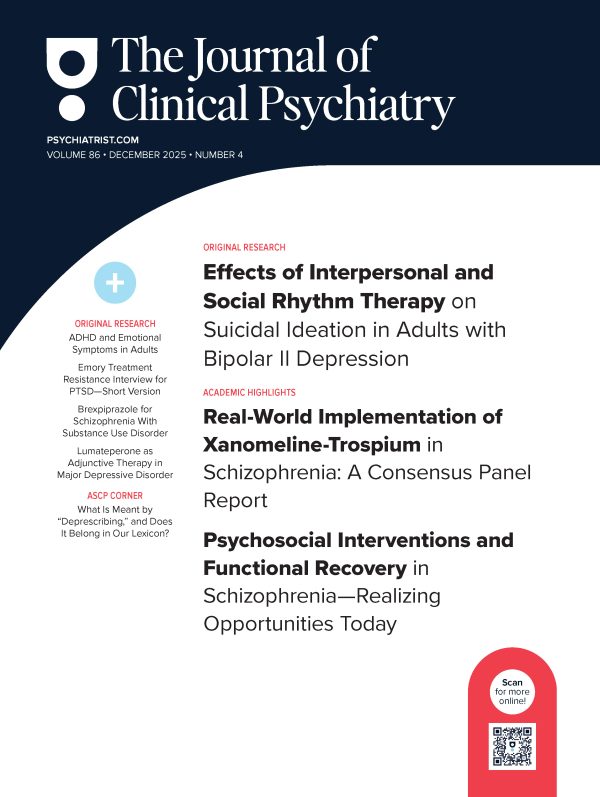Abstract
Objectives: The first purpose of this study was to determine time to attainment of symptomatic remissions and recoveries of 2–12 years duration for those with borderline personality disorder (BPD) and patients with other personality disorders (OPDs); the second was to determine the stability of these outcomes.
Methods: Two hundred ninety inpatients meeting both Revised Diagnostic Interview for Borderlines (DIB-R) and DSM III-R criteria for BPD and 72 patients with OPDs were assessed during their index admission using a series of semistructured interviews. The same instruments were readministered at 12 contiguous 2-year time periods.
Results: Patients with BPD were significantly slower to achieve remission or recovery (which involved good social and vocational functioning as well as symptomatic remission) than patients with OPD. However, those in both study groups ultimately achieved about the same high rates of remission (BPD patients: 77%–100%; patients with OPD: 97%–100%) but not recovery (37%–60% vs 68%–89%) by the time of the 24-year follow-up. In contrast, symptomatic recurrence (11%–40% vs 5%–10%) and loss of recovery (29%–59% vs 15%–42%) occurred more rapidly and at substantially higher rates among BPD patients than patients with OPD.
Conclusions: Taken together, the results of this study suggest that sustained symptomatic remission is substantially more common than sustained recovery from BPD. They also suggest that loss of sustained recovery is more common than symptomatic recurrences for those with BPD.
J Clin Psychiatry 2024;85(4):24m15457
Author affiliations are listed at the end of this article.
Members Only Content
This full article is available exclusively to Professional tier members. Subscribe now to unlock the HTML version and gain unlimited access to our entire library plus all PDFs. If you’re already a subscriber, please log in below to continue reading.
References (29)

- McGlashan TH. The Chestnut Lodge follow-up study. III. Long-term outcome of borderline personalities. Arch Gen Psychiatry. 1986;43(1):20–30. PubMed CrossRef
- Paris J, Zweig-Frank H. A 27 year follow-up of patients with borderline personality disorder. Compr Psychiatry. 2001;42(6):482–487. PubMed CrossRef
- Plakun EM, Burkhardt PE, Muller JP. 14-year follow-up of borderline and schizotypal personality disorders. Compr Psychiatry. 1985;26(5):448–455. PubMed CrossRef
- Stone MH. The Fate of Borderline Patients. Guilford Press; 1990.
- Zanarini MC, Frankenburg FR, Reich DB, et al. Time to attainment of recovery from borderline personality disorder and stability of recovery: a 10-year prospective follow-up study. Am J Psychiatry. 2010;167(6):663–667. PubMed CrossRef
- Gunderson JG, Stout RL, McGlashan TH, et al. Ten-year course of borderline personality disorder: psychopathology and function from the Collaborative Longitudinal Personality Disorders study. Arch Gen Psychiatry. 2011;68(8):827–837. PubMed CrossRef
- Zanarini MC, Frankenburg FR, Hennen J, et al. The longitudinal course of borderline psychopathology: 6-year prospective follow-up of the phenomenology of borderline personality disorder. Am J Psychiatry. 2003;160(2):274–283. PubMed CrossRef
- Zanarini MC, Frankenburg FR, Reich DB, et al. Attainment and stability of sustained symptomatic remission and recovery among patients with borderline personality disorder and axis II comparison subjects: a 16-year prospective follow-up study. Am J Psychiatry. 2012;169(5):476–483. PubMed CrossRef
- Zanarini MC. Background Information Schedule. McLean Hospital; 1992.
- Spitzer RL, Williams JB, Gibbon M, et al. The Structured Clinical Interview for DSM-III-R (SCID). I: history, rationale, and description. Arch Gen Psychiatry. 1992; 49(8):624–629. PubMed CrossRef
- Zanarini MC, Gunderson JG, Frankenburg FR, et al. The Revised Diagnostic Interview for Borderlines: discriminating BPD from other Axis II disorders. J Pers Disord. 1989;3(1):10–18.
- Zanarini MC, Frankenburg FR, Chauncey DL, et al. The Diagnostic Interview for Personality Disorders: inter-rater and test-retest reliability. Compr Psychiatry. 1987;28(6):467–480. PubMed CrossRef
- Zanarini MC, Frankenburg FR, Hennen J, et al. Psychosocial functioning of borderline patients and axis II comparison subjects followed prospectively for six years. J Pers Disord. 2005;19(1):19–29. PubMed CrossRef
- Zanarini MC, Frankenburg FR, Vujanovic AA. Inter-rater and test-retest reliability of the Revised Diagnostic Interview for Borderlines. J Pers Disord. 2002;16(3):270–276. PubMed CrossRef
- Zanarini MC, Frankenburg FR. Attainment and maintenance of reliability of axis I and II disorders over the course of a longitudinal study. Compr Psychiatry. 2001;42(5):369–374. PubMed CrossRef
- Zanarini MC, Sickel AE, Yong L, et al. Revised Borderline Follow-Up Interview. McLean Hospital; 1994.
- Hollingshead AB. Two Factor Index of Social Position. Yale University; 1957.
- American Psychiatric Association. Diagnostic and Statistical Manual of Mental Disorders. 3rd rev ed. American Psychiatric Association; 1987:32.
- Solomon DA, Keller MB, Leon AC, et al. Recovery from major depression: a 10- year prospective follow-up across multiple episodes. Arch Gen Psychiatry. 1997;54(11):1001–1006. PubMed CrossRef
- Mueller TI, Leon AC, Keller MB, et al. Recurrence after recovery from major depressive disorder during 15 years of observational follow-up. Am J Psychiatry. 1999;156(7):1000–1006. PubMed CrossRef
- Judd LL, Akiskal HS, Schettler PJ, et al. The long-term natural history of the weekly symptomatic status of bipolar I disorder. Arch Gen Psychiatry. 2002;59(6):530–537. PubMed CrossRef
- Judd LL, Schettler PJ, Solomon DA, et al. Psychosocial disability and work role function compared across the long-term course of bipolar I, bipolar II, and unipolar major depressive disorders. J Affect Disord. 2008;108(1–2):49–58. PubMed CrossRef
- Zanarini MC, Frankenburg FR, Glass IV, et al. The 24-year course of symptomatic disorders in patients with borderline personality disorder and personality disordered comparison subjects: description and prediction of recovery from BPD. J Clin Psychiatry. 2024;85(3):24m15370. PubMed CrossRef
- Zanarini MC, Frankenburg FR, Reich DB, et al. The 10-year course of psychosocial functioning among patients with borderline personality disorder and axis II comparison subjects. Acta Psychiatr Scand. 2010;122(2):103–109. PubMed CrossRef
- Zanarini MC, Jacoby RJ, Frankenburg FR, et al. The 10-year course of social security disability income reported by patients with borderline personality disorder and axis II comparison subjects. J Pers Disord. 2009;23(4):346–356. PubMed CrossRef
- Pucker HE, Temes CM, Zanarini MC. Description and prediction of social isolation in borderline patients over 20 years of prospective follow-up. Personal Disord. 2019;10(4):383–388. PubMed CrossRef
- Gecha TC, Glass IV, Frankenburg FR, et al. Experiential avoidance in participants with borderline personality disorder and other personality disorders. Borderline Personal Disord Emot Dysregul. 2024;11(1):6. PubMed
- Zanarini MC, Frankenburg FR, Reich DB, et al. Treatment rates for patients with borderline personality disorder and other personality disorders: a 16-year study. Psychiatr Serv. 2015;66(1):15–20. PubMed CrossRef
- Zanarini MC, Frankenburg FR, Bradford Reich D, et al. Rates of psychotropic medication use reported by borderline patients and axis II comparison subjects over 16 Years of prospective follow-up. J Clin Psychopharmacol. 2015;35(1):63–67. PubMed CrossRef


